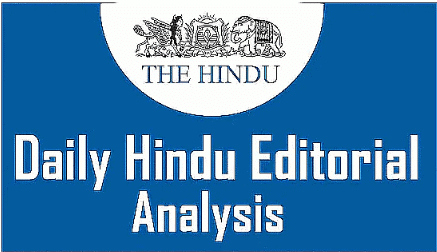The Hindu Editorial Analysis- 8th May 2025 | Current Affairs & Hindu Analysis: Daily, Weekly & Monthly - UPSC PDF Download

The HDI and India’s Progress
Why is it Newsworthy?
- The recent report on the Human Development Index (HDI) has been published, showcasing India's advancements and the areas that require enhancement in terms of human development metrics.
Grasping HDI
- HDI is an aggregated index that evaluates average performance across three fundamental dimensions:
- Health: Measured by life expectancy at birth.
- Education: Assessed through mean years of schooling for adults and expected years of schooling for children.
- Standard of Living: Gauged by Gross National Income (GNI) per capita.
India’s Standing
- India has made strides in life expectancy and educational indicators, reflecting positive developments in these areas.
- Despite these improvements, challenges such as income inequality and gender disparities continue to be significant hurdles.
Identified Challenges
- There are ongoing regional disparities in human development outcomes, indicating uneven progress across different areas.
- There is a need for better public health infrastructure and educational quality to support overall development.
- Addressing income inequality and ensuring inclusive growth are critical challenges that need to be tackled.
Path Forward
- Investing in health and education sectors is essential to enhance overall human development outcomes.
- Implementing targeted policies aimed at reducing regional and gender disparities will be crucial.
- Strengthening social protection measures to support vulnerable populations is necessary to ensure inclusive growth.
Strokes of justice
Why is it News?
India needs to be ready for possible aggressive actions from Pakistan.
Introduction
India recently carried out precise military strikes on nine locations in Pakistan and Pakistan-occupied Kashmir, targeting terrorist camps associated with Jaish-e-Mohammed and Lashkar-e-Taiba. This action, following a deadly terrorist attack in Pahalgam, aims to disrupt cross-border terrorism and signifies a shift in India’s strategy towards a more robust military, economic, and diplomatic response to Pakistan-sponsored terrorism.
Overview of India’s Precision Military Strikes
Date and Targets: On a recent Wednesday, India executed precision military strikes on nine sites in Pakistan and Pakistan-occupied Kashmir (PoK). The main targets were:
- Bahawalpur: Home to the Jaish-e-Mohammed headquarters.
- Muridke:. central hub for Lashkar-e-Taiba.
Objective: The primary goal of these strikes was to dismantle terrorist training camps and prevent future cross-border attacks. This action was prompted by the Pahalgam terrorist attack on April 22, which resulted in the deaths of 26 individuals.
Nature of the Strikes: The military characterized the strikes as:
- Measured and non-escalatory: Aimed at avoiding further escalation.
- Proportionate and responsible: Ensuring a balanced and accountable response.
Comparison with Previous Strikes
- Previous Operations: In 2019, India conducted surgical strikes in Balakot, Pakistan, following the Pulwama attack.
- Current Operation: The recent response has been sharper and more decisive compared to past actions.
- Significance of Targets: Muridke and Bahawalpur are situated in Punjab, the core region of Pakistan’s ruling elite, which has a historical association with terrorism.
India’s Response to Pakistan’s Use of Terrorism
- Pakistan’s Strategy: Pakistan has employed terrorism as a low-cost strategy against India, often under the threat of nuclear blackmail. Despite being an ally in the war on terror, Pakistan has sheltered notorious terrorists like Osama bin Laden.
- Shift in India’s Military Strategy: Under Prime Minister Narendra Modi, India has shifted towards explicit military action against Pakistan-sponsored terrorism. This approach indicates a readiness for military, economic, and diplomatic responses to future terrorist incidents.
- International Pressure on Pakistan: India has called on global powers to use their influence to compel Pakistan towards responsible behavior.
Continued Investigation and Political Unity
- Ongoing Investigation: The investigation into the Pahalgam attack should continue with full commitment and be pursued to its conclusion.
- Political Support: There is a consensus among political parties in support of the military operation. The Centre also needs to curb elements that provoke communal discord, as such actions could be exploited by Pakistan.
- Preparedness for Escalation: India must stay alert for any aggressive moves from Pakistan and be ready to respond both militarily and diplomatically.
Conclusion
India’s recent military strikes represent a significant change in its approach to Pakistan-sponsored terrorism, indicating a stronger and more direct response to cross-border attacks. While the strikes aimed at terrorist infrastructure, the long-term alteration of Pakistan’s behavior remains uncertain. Ongoing vigilance, international pressure on Pakistan, and a united domestic front are crucial for preventing further escalation and ensuring enduring security.
|
38 videos|5293 docs|1118 tests
|
FAQs on The Hindu Editorial Analysis- 8th May 2025 - Current Affairs & Hindu Analysis: Daily, Weekly & Monthly - UPSC
| 1. What is the Human Development Index (HDI) and how is it calculated? |  |
| 2. How has India's HDI changed over the years? |  |
| 3. What are the key challenges India faces in improving its HDI? |  |
| 4. How does the HDI reflect social justice in a country like India? |  |
| 5. Why is it important for India to improve its HDI ranking? |  |





















